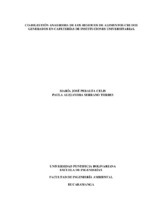| dc.contributor.advisor | Cerón Vivas, Alexandra | |
| dc.contributor.author | Peralta Celis, María José | |
| dc.contributor.author | Serrano Torres, Paula Alejandra | |
| dc.coverage.temporal | 2020 | |
| dc.date.accessioned | 2021-07-22T15:58:49Z | |
| dc.date.available | 2021-07-22T15:58:49Z | |
| dc.date.issued | 2020-03 | |
| dc.identifier.uri | http://hdl.handle.net/20.500.11912/8853 | |
| dc.description | 78 páginas | spa |
| dc.description.abstract | La Co-digestión anaerobia es un método de tratamiento de residuos orgánicos en donde se mezclan varios residuos para tener una mejor producción de biogás. Por eso, el objetivo de este estudio fue evaluar la producción de metano (CH4) mediante la Co-digestión anaerobia de los residuos de alimentos crudos generados en la cafetería del K de la Universidad Pontificia Bolivariana. Inicialmente, se caracterizó el lodo utilizado como inóculo a través de la Actividad Metanogénica Específica (AME), arrojando un valor de 0,071 ml DQO/g SV*d. Se evaluaron diferentes Co-sustratos (Jacinto de agua-JA y residuos de poda-PO) y proporciones de mezclas (40:60 y 30:70) para la Co-digestión de los residuos alimenticios crudos (CR). A partir de pruebas de Potencial Bioquímico de Metano (PBM), los mayores valores de PBM fueron para las relaciones de CR/PO 40:60 (71,163104 ml CH4/g SV) y CR/JA 30:70 (54,0938457 ml CH4/g SV), considerando que los residuos crudos son un sustrato rápidamente acidificable y que poseen un porcentaje alto de material biodegradable. Sin embargo, el ensayo que se realizó de mono-digestión demostró con un valor de PBM para poda de 272,360 ml CH4/g SV ser más eficiente que la Co-digestión. Como factor limitante, estuvo el pH de la relación CR/PO 30:70 arrojando un valor de 4,02 unidades al finalizar las pruebas de PBM. Además, se consideró que el lodo no se adaptó a los residuos utilizados en la investigación. | spa |
| dc.description.abstract | The anaerobic co-digestion it’s a method of organic waste treatment where several wastes are mixed to have a better biogas production. Therefore, the objective of this study was to evaluate the production of CH4 through anaerobic co-digestion of raw food waste generated in the cafeteria K of Universidad Pontificia Bolivariana. Initially, the sludge used as inoculum was characterized through the AME, yielding a value of 0.071 ml COD / g SV * d. Different co-substratres were evaluated (water hyacinth-JA and pruning waste PO) and mix ratios (40:60 and 30:70) for the codigestion of raw food waste (CR). From the biochemical potential tests of methane (PBM), the highest PBM values were for the ratios of CR/PO 40:60 (71,163104 ml CH4/g SV) y CR/JA 30:70 (54,0938457 ml CH4/g SV), considering that raw waste is a rapidly acidifiable substrate and that it has a high percentage of biodegradable material. However, the mono-digestion test was demonstrated with a pruning value of PBM of 272,360 ml CH4/g SV to be more efficient than Codigestion. As a limiting factor, the relationship between the pH and CR/PO 30:70 are throwing a value of 4,02 units in the PBM. In addition, it was considered that the sludge was not adapted to the waste used in the investigation. | eng |
| dc.format.mimetype | application/pdf | |
| dc.language.iso | spa | |
| dc.publisher | Universidad Pontificia Bolivariana | spa |
| dc.rights | Attribution-NonCommercial-NoDerivatives 4.0 International | * |
| dc.rights.uri | http://creativecommons.org/licenses/by-nc-nd/4.0/ | * |
| dc.subject | Universidades - Universidad Pontificia Bolivariana | spa |
| dc.subject | Residuos de alimentos | spa |
| dc.subject | Anaerobia | spa |
| dc.subject | Poda | spa |
| dc.subject | Cafeterías | spa |
| dc.title | Co-digestión anaerobia de los residuos de alimentos crudos generados en cafeterías de instituciones universitarias | spa |
| dc.type | Trabajo de grado | spa |
| dc.publisher.department | Escuela de Ingenierías | spa |
| dc.publisher.program | Ingeniería Ambiental | spa |
| dc.type.hasVersion | publishedVersion | spa |
| dc.description.sectional | Bucaramanga | spa |
| dc.description.degreename | Ingeniero Ambiental | spa |


